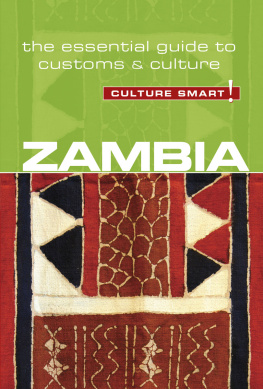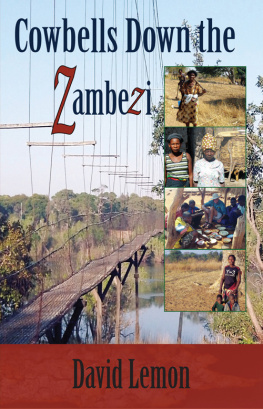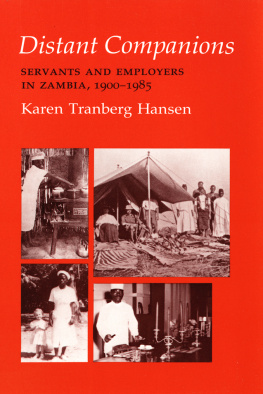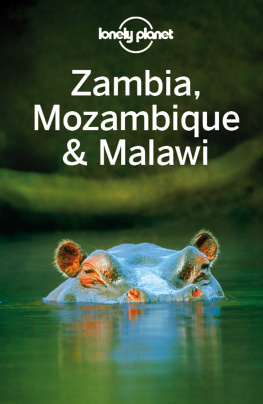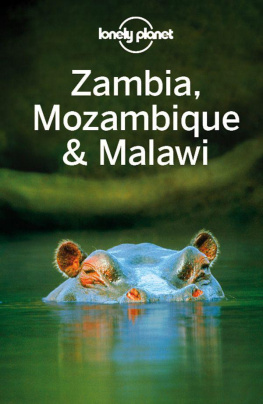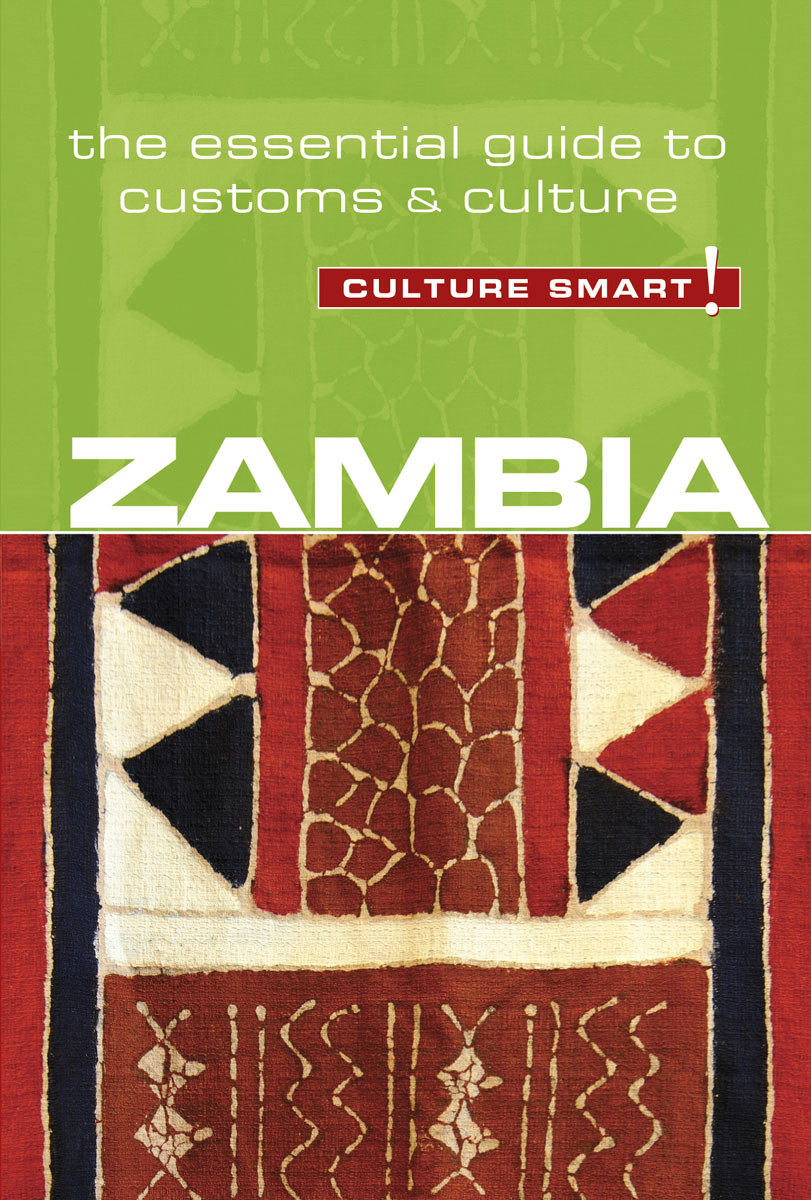
This book is available for special discounts for bulk purchases for sales promotions or premiums. Special editions, including personalized covers, excerpts of existing books, and corporate imprints, can be created in large quantities for special needs.
For more information contact Kuperard publishers at the address below.
ISBN 978 1 85733 877 5
British Library Cataloguing in Publication Data
A CIP catalogue entry for this book is available from the British Library
First published in Great Britain
by Kuperard, an imprint of Bravo Ltd
59 Hutton Grove, London N12 8DS
Tel: +44 (0) 20 8446 2440 Fax: +44 (0) 20 8446 2441
www.culturesmart.co.uk
Inquiries:
Series Editor Geoffrey Chesler
Design Bobby Birchall
Printed in India
Cover image: Hand-printed cotton table runner showing the markings of a giraffe. Lusaka craft market. Alamy
The photographs on pages are reproduced by permission of the author.
Images on the following pages reproduced under Creative Commons Attribution-Share Alike 4.0 International license: Tigana chileshe.
Reproduced under Creative Commons Attribution-Share Alike 3.0 Unported license: Sumeet Moghe.
Creative Commons Attribution-Share Alike 2.5 Generic license: Jpatokal.
Creative Commons Attribution-Share Alike 2.0 Generic license: Lars Plougmann from London, United Kingdom.
Creative Commons CC0 1.0 Universal Public Domain Dedication: Daderot.
About the Author
ANDREW LORYMAN, after graduating with an M.A.Ed. from Brunel University, London, lived and taught in Zambia for twenty years, working in mission, government, private and mine schools in Western, Central, and Lusaka Provinces. Formerly the national coach for the Zambia mens volleyball team, and for many years chairman of the schools volleyball association, he has spent time in every province in the country. During his years in Zambia he also wrote articles for the Zambia Daily Mail, using the name Sitali Mulenga, and with his wife, who is Zambian, ran a chain of hair salons and a tailoring business, and kept 2,000 chickens and ducks on a small farm.
The Culture Smart! series is continuing to expand. All Culture Smart! guides are available as e-books, and many as audio books.
For latest titles visit
www.culturesmart.co.uk
The publishers would like to thank CultureSmart!Consulting for its help in researching and developing the concept for this series.
CultureSmart!Consulting creates tailor-made seminars and consultancy programs to meet a wide range of corporate, public-sector, and individual needs. Whether delivering courses on multicultural team building in the USA, preparing Chinese engineers for a posting in Europe, training call-center staff in India, or raising the awareness of police forces to the needs of diverse ethnic communities, it provides essential, practical, and powerful skills worldwide to an increasingly international workforce.
For details, visit www.culturesmartconsulting.com
CultureSmart!Consulting and CultureSmart! guides have both contributed to and featured regularly in the weekly travel program Fast Track on BBC World TV.
contents
Map of Zambia

introduction
Zambia is big! It is larger than the combined size of Germany and Norway. Lake Bangweulu and its wetlands alone cover an area larger than Northern Ireland, while the Kafue National Park is bigger than Wales. This landlocked country in central southern Africa is named after the mighty Zambezi River, which rises in the remote Kalene Hills in its northwest. Mineral-rich, with huge untapped agricultural, water, energy, and human potential, it sits on the investors leader board for Africa.
Zambia has a stunning landscape of forest, woodland, and grassland, traversed by mighty rivers whose journeys are marked by floodplains, swamps, waterfalls, lakes, and long, languid loops to the sea. David Livingstone, the Victoria Falls, Lake Karibathese magical names, together with the spectacular wealth of bird and wildlife and the range of luxurious lodges and tented camps set in the African countryside, make it the upscale safari destination of choice. The city of Livingstone is the high-octane capital of southern Africa, offering bungee jumping, zip-lining, river rafting, and other activities for those seeking an adrenaline rush.
Apart from the obvious tourist attractions, Zambia is also a living celebration of multiculturalism. It is a potpourri of traditions, ceremonies, and customs taken from seventy-two ethnic groups, and as English is widely used it is easy for foreigners to engage with its lively, good-humored people.
The Zambians have moved through diverse tribal histories, European colonization, socialist philosophy and rhetoric, and, finally, a gung-ho charge into multiparty capitalism in the early 1990s. Today Zambia is a forward-thinking democracy, with life played out against the backdrop of unspoiled countryside and rich cultural traditions. It is one of the most urbanized countries in sub-Saharan Africamore than 40 percent of the population live in urban areas. The burgeoning tourist industry, the presence of huge mining organizations, and the growth of commercial farming enterprises have all had an impact on Zambian society, sharpening the distinction between traditional village life, largely unchanged for centuries, and modern urban life, whether in exclusive gated communities, rented apartment blocks, or unplanned shanty towns.
By and large the Zambians are taking this change in their stride. Their equanimity and geniality are based upon a carefree attitude to life and the realization that worrying about something doesnt actually ameliorate the problem: its better, as the Chewa say, to smile and show your teethKukondwa ndi kuonetsa mano!
Culture Smart! Zambia goes beyond the tourist panorama of pristine nature and the busy urban life, luxury hotels, shopping malls, and rush-hour bottlenecks of the big cities. It describes the psyche of a people who have been shaped by their geography and history, who are notable for their warmth, outgoing nature, and zest for life. We hope to offer an insight into the feelings, behavior, and ideas that permeate Zambian society, to enable you to understand your hosts more fully and so make the most of your stay.
Key Facts
Official Name | Republic of Zambia | Independent on October 24, 1964 |
Capital City | Lusaka | Pop: 2.179 million |
Main Towns and Cities | Kitwe, Ndola, Kabwe, Chingola, Mufulira, Livingstone | 10 provinces, each with a provincial capital |
Area | 290,587 sq. miles (752,618 sq.km) |
Topography | A high plateau drained by the Congo River in the north and the Zambezi and Kafue Rivers in the south, west, and center, with low areas in and around the river valleys. Five major rivers, 4 major lakes, and more than 20 waterfalls, including the Victoria Falls |
Population | 17,403,875 (2017) | Growth rate: 2.94% (est.) |
|
Next page
